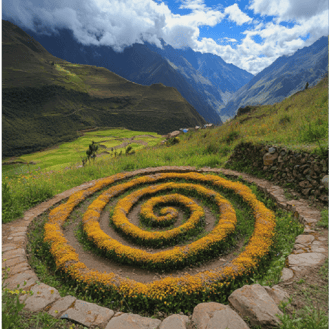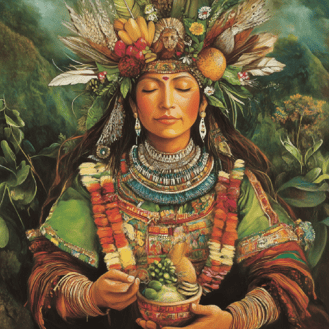Pachamama – Embracing the Andean Mother Earth in Springtime
Discover the wisdom and nurturing power of Pachamama, the Andean Mother Earth. This blog explores her deep connection to fertility, abundance, and ecological balance, while offering meaningful ways to honor her spirit in daily life. Learn about sacred rituals, offerings, and how to align with her energy for harmony and renewal. 🌿✨
GODDESSES
Goddess Hive
2/13/20254 min read
Welcome, Goddess Hive! Some links in this blog are affiliate links. Meaning, if you choose to shop through the links on this page, a small percentage of the sale will go to me at no additional cost to you. Thank you for your support. Goddess bless.
Awakening to Pachamama: Embracing the Sacred Earth Mother
Spring whispers renewal and the lush rebirth of the Earth, making it the perfect season to connect with Pachamama, the Andean Mother Earth. She is the nurturing force behind life’s cycles, a timeless goddess whose influence spans human history. For those seeking spiritual grounding and ecological harmony, understanding Pachamama’s essence brings profound meaning and connection.
Origins of Pachamama
Pachamama originates from the ancient Andean civilizations, where she was revered as a goddess of fertility, agriculture, and ecological balance. Her name combines "pacha," meaning Earth or time, with "mama," which translates to mother. Together, Pachamama signifies Mother Earth, embodying the nurturing power of soil, air, and water that sustain life.
In the Andes, she was not only a deity of worship but also a symbol of practical sustenance. Farmers turned to her for bountiful harvests, performing rituals to ensure the soil’s fertility. Her presence was seen as the guardian of harmony between humans and nature—a relationship spring revives through planting and renewal.
Pachamama's Followers and Sacred Artifacts
Pachamama is the eternal protector of the natural world, embodying life’s cycles from sowing to reaping. Her guidance resonates with the Quechua and Aymara peoples of the Andes, who still honor her with ceremonies, offerings, and festivals. These rituals often involve ch’alla, a tradition of pouring offerings like cornmeal, coca leaves, and wine onto the Earth to express gratitude and maintain balance.
Artifacts bearing Pachamama’s presence include clay figurines of pregnant women, symbolizing fertility and abundance, as well as ceremonial bowls and textiles adorned with her sacred symbols. The vibrant art and intricate weavings passed down through generations reflect her enduring influence.
The Sacred Symbol of Pachamama
The Chakana, or Andean Cross, stands as Pachamama’s sacred symbol. Its geometric design represents the union of the physical and spiritual realms, with its four arms embodying the elements of Earth, water, air, and fire. The Chakana’s symmetry also reflects the balance Pachamama brings to life’s cycles, urging humanity to live in harmony with nature.
Additionally, the spiral—often found in Andean art—symbolizes her nurturing embrace and the cyclical nature of existence. These symbols evoke her omnipresent care and the interconnectedness of all life.
Pachamama’s Consort: The Absence of a Divine Mate
Unlike many deities in global mythologies, Pachamama remains unmated. This absence underscores her self-sufficiency and autonomous power. She embodies the completeness of nature’s cycles without requiring a counterpart, symbolizing the Earth’s ability to nurture, sustain, and renew itself. This independence adds to her allure, reinforcing her as a source of strength and inspiration for those seeking self-reliance and balance.
Controversies and Modern Marginalization
The arrival of Spanish colonizers in the Andes marked a significant shift in Pachamama’s status. Indigenous spiritual practices were suppressed, and Catholicism sought to replace Pachamama with the Virgin Mary. This religious and cultural colonization marginalized the goddess, branding her worship as pagan or primitive.
Despite these efforts, Pachamama’s influence endured in secret rituals and oral traditions. Today, as environmental awareness rises, she reclaims her place in modern spirituality, symbolizing a much-needed return to ecological stewardship and respect for Earth’s resources.
Modern Relevance of Pachamama
In an era marked by climate change and environmental degradation, Pachamama’s teachings offer timeless wisdom. She reminds us of our duty to protect and honor the Earth, fostering a symbiotic relationship rather than one of exploitation. Her relevance extends beyond the Andes, inspiring global movements focused on sustainability, conservation, and living in harmony with nature.
For modern spiritual seekers, Pachamama serves as a grounding force, encouraging mindfulness and a deeper connection to the natural world. By embracing her, we align ourselves with the rhythms of life, finding renewal and purpose, especially during the vibrant season of spring.
How to Connect with Pachamama in Daily Life
Connecting with Pachamama doesn’t require a pilgrimage to the Andes. Simple, heartfelt practices can honor her wherever you are:
Spring Rituals: Create a small Earth altar with natural elements like stones, flowers, and soil. Offer gratitude for the season’s renewal and abundance.
Eco-Conscious Living: Practice sustainability by reducing waste, conserving water, and supporting eco-friendly initiatives.
Gardening: Plant flowers, herbs, or vegetables as a tribute to her nurturing essence. Tend to your garden with care and intention, embodying her values of growth and renewal.
Meditation and Grounding: Spend time outdoors, walking barefoot to connect physically and spiritually with the Earth. Meditate on her cycles, visualizing her energy flowing through you.
Pachamama invites us to rediscover our bond with the Earth, to live harmoniously with her cycles, and to honor the sacredness of life. This spring, let her wisdom guide you in celebrating renewal, growth, and the eternal dance of life. By embracing Pachamama, we nurture not only the Earth but also our souls, fostering a world where nature and humanity thrive together.
FAQs About Pachamama
1. What offerings are appropriate for Pachamama? Offerings such as coca leaves, cornmeal, wine, and flowers are traditional. You can also offer your heartfelt gratitude and prayers.
2. Is Pachamama worship limited to the Andes? While her roots are in the Andes, anyone can honor Pachamama as a symbol of Earth’s nurturing power and ecological balance.
3. Are there specific festivals dedicated to Pachamama? Yes, August is often considered her sacred month, marked by rituals and festivals in Andean communities.
4. How can I incorporate Pachamama’s teachings into my daily routine? Embrace sustainable practices, spend time in nature, and express gratitude for life’s abundance. These simple acts align you with her energy.
5. What is Pachamama’s connection to spring? Spring embodies renewal and fertility, which resonate deeply with Pachamama’s essence as the life-giving force of nature.
Sources for Further Exploration
Dean, Carolyn. Inka Bodies and the Body of Christ: Corpus Christi in Colonial Cuzco, Peru. Duke University Press, 1999.
Allen, Catherine J. The Hold Life Has: Coca and Cultural Identity in an Andean Community. Smithsonian Institution Press, 2002.
Bastien, Joseph W. Mountain of the Condor: Metaphor and Ritual in an Andean Ayllu. Waveland Press, 1985.
Wright, Kenneth R. Machu Picchu: A Civil Engineering Marvel. ASCE Press, 2000.






About us
The content provided on OMG, including blog posts, rituals, prayers, meditations, and other materials, is intended for informational, educational, and spiritual enrichment purposes only. It is not a substitute for professional medical advice, diagnosis, or treatment. If you have any concerns regarding your physical or mental health, please consult a qualified healthcare profession.
Take care of yourself first, then take care of everyone else. That is the nature of Goddess-ship.
Be well. Goddess Bless.
Empowerment
Empowering femininity through education and self-care.
Goddess
goddesshive@ohmygoddess.com
© 2024. All rights reserved.
